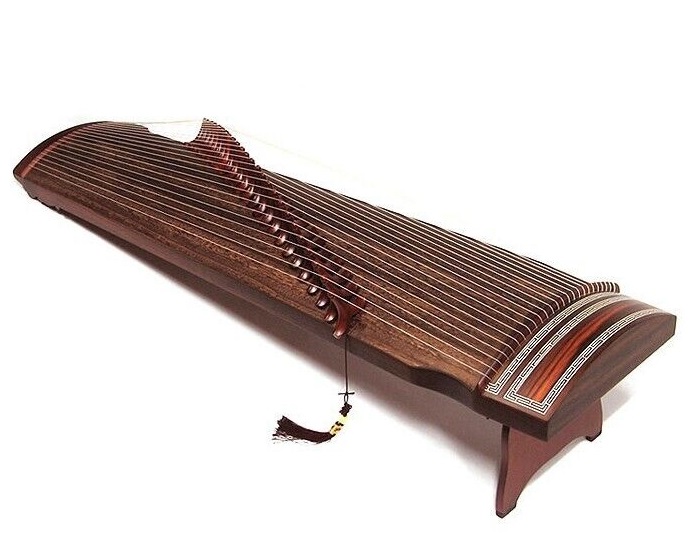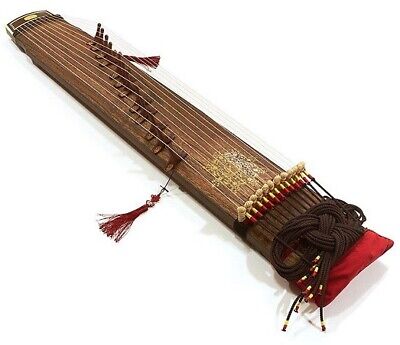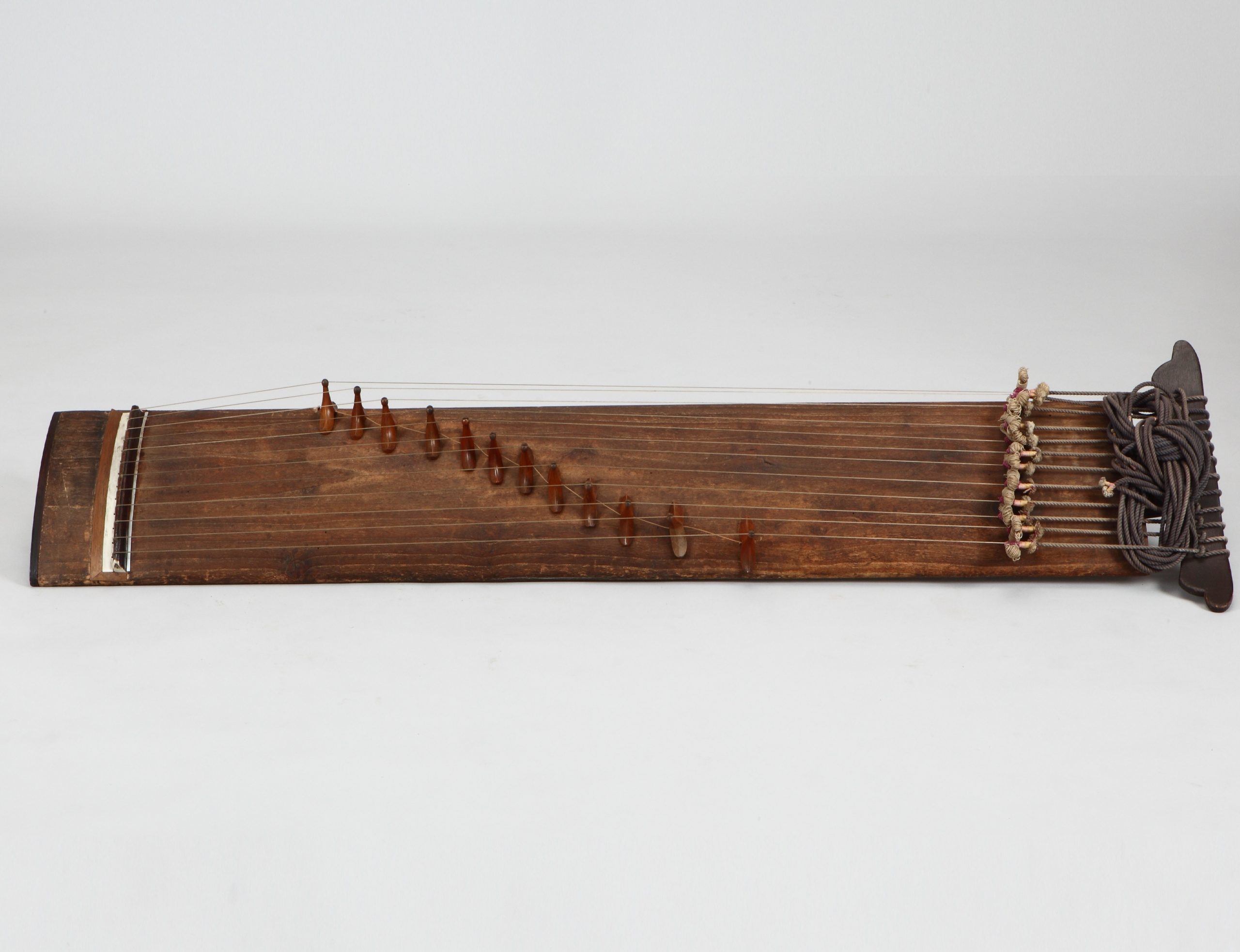Gayageum
Plucked Instruments
Asia
Between 0 and 1000 AD
Video
The gayageum, a quintessential Korean zither, stands as a symbol of the nation’s rich musical heritage.
It is a long, narrow, plucked string instrument, traditionally crafted from paulownia wood, though other materials are now sometimes used. The gayageum’s distinctive sound, characterized by its warm, mellow tones and expressive vibrato, has captivated audiences for centuries. Musicians coax a wide range of emotions from the instrument, from delicate melodies to powerful, resonant chords. The gayageum is not merely a musical instrument; it is a cultural icon, representing the elegance, refinement, and artistic sensibility of Korean traditional music. Its presence in court music, folk genres, and contemporary compositions underscores its enduring significance in Korean society. The instrument’s ability to evoke a sense of serenity and emotional depth makes it a unique and treasured part of the global musical landscape.
Type of Instrument
The gayageum is classified as a plucked string instrument, specifically a long zither. Its strings are stretched across a resonating soundboard, and the musician produces sound by plucking or strumming them. Unlike bowed string instruments, the gayageum relies on the direct manipulation of the strings by the fingers to create its characteristic sound. The instrument’s design, with its movable bridges (anjok) and silk or nylon strings, allows for a wide range of tonal variations and expressive techniques. It falls within the broader category of East Asian zithers, sharing similarities with instruments such as the Japanese koto and the Chinese guzheng. However, the gayageum’s unique construction, playing style, and musical repertoire distinguish it as a distinct and significant instrument within this family. The gayageum’s ability to produce both melodic and harmonic sounds, coupled with its expressive potential, makes it a versatile instrument capable of conveying a wide spectrum of musical ideas.
History of the Gayageum
The history of the gayageum spans several centuries, with its origins tracing back to the ancient Korean kingdom of Gaya during the 6th century. According to the “Samguk Sagi” (History of the Three Kingdoms), King Gasil of Gaya created the gayageum by modeling it after an existing Chinese instrument, improving upon its design to better suit Korean musical sensibilities. Initially, it was a 12-stringed instrument, primarily used in court music and ritual ceremonies. Over time, the gayageum spread throughout the Korean peninsula, evolving and adapting to regional musical styles. During the Joseon Dynasty (1392-1897), the gayageum experienced a period of significant development, with the emergence of new musical genres and playing techniques. The sanjo style, a form of improvised solo music, became particularly popular, showcasing the instrument’s expressive capabilities.
In the 20th century, the gayageum faced challenges during the Japanese colonial period, but it also witnessed a revival after the Korean War. Contemporary composers have continued to explore new possibilities for the gayageum, incorporating it into diverse musical contexts and blending traditional elements with modern influences. Its journey from ancient court instrument to a symbol of Korean cultural identity reflects its enduring appeal and adaptability. The Gayageum’s history is deeply intertwined with the cultural and political developments of the Korean peninsula, reflecting the changing tastes and artistic expressions of its people across the centuries.
Construction and Design
The construction of the gayageum is a meticulous process, requiring skilled craftsmanship and precise attention to detail. The instrument’s body is typically made from a single piece of paulownia wood, chosen for its resonant qualities and lightweight nature. The soundboard, which forms the upper surface of the instrument, is carefully carved to achieve the desired thickness and curvature. The underside of the soundboard is often hollowed out to enhance resonance and tonal projection. The strings, traditionally made of twisted silk, are now often crafted from nylon or synthetic materials for durability and consistency. They are stretched across the soundboard and secured to tuning pegs at one end and to a bridge at the other. The anjok, or movable bridges, play a crucial role in determining the pitch of the strings and allowing for subtle variations in intonation. These bridges, traditionally made of ivory or bone, are now often made of plastic or other synthetic materials. The gayageum’s design also features a tailpiece, which anchors the strings at the lower end of the instrument. The overall shape of the gayageum is long and narrow, with a slightly convex soundboard and a flat or slightly concave underside. The instrument’s elegant and understated design reflects the aesthetic values of Korean traditional culture. The selection of materials, the precision of craftsmanship, and the thoughtful design contribute to the gayageum’s unique tonal qualities and expressive potential.
Types of Gayageum
The gayageum has evolved over time, resulting in several distinct types, each with its own characteristics and musical applications. The most common types include the 12-string sanjo gayageum, the 21- or 25-string gaeyang gayageum, and the 18-string danso gayageum. The sanjo gayageum, traditionally used for solo performances in the sanjo style, is known for its expressive melodies and intricate ornamentation. It is the most widely recognized and played type of gayageum. The gaeyang gayageum, a modernized version of the instrument, features an expanded range and enhanced volume, making it suitable for ensemble performances and contemporary compositions. Its increased number of strings allows for greater harmonic complexity and melodic possibilities. The danso gayageum, a smaller version of the instrument, is often used in folk music and for accompanying vocal performances. It is characterized by its bright, clear tone and its portability. In addition to these main types, there are also regional variations of the gayageum, reflecting the diverse musical traditions of different parts of Korea. Each type of gayageum possesses its own unique sonic qualities and playing techniques, contributing to the rich tapestry of Korean traditional music. The development of different gayageum types reflects the instrument’s adaptability and the ongoing evolution of Korean musical culture.
Characteristics of the Gayageum
The gayageum is distinguished by its unique tonal characteristics, expressive capabilities, and playing techniques. Its sound is often described as warm, mellow, and resonant, with a distinctive vibrato that adds depth and emotion to the music. The instrument’s silk or nylon strings produce a rich, nuanced tone that can range from delicate whispers to powerful chords. The anjok, or movable bridges, allow for subtle variations in pitch and intonation, enabling musicians to create a wide range of expressive effects. The gayageum’s playing techniques include plucking, strumming, bending, and vibrato, each contributing to the instrument’s expressive potential.
Musicians use their fingers, often adorned with ivory or plastic finger picks, to manipulate the strings and create a variety of sounds. The left hand is used to press or pull the strings, creating vibrato and other ornaments, while the right hand plucks or strums the strings to produce the main melody. The gayageum’s expressive capabilities are particularly evident in the sanjo style, a form of improvised solo music that showcases the instrument’s virtuosity and emotional depth. The instrument’s ability to convey a wide range of emotions, from joy and sorrow to tranquility and passion, makes it a powerful tool for musical expression. The gayageum’s unique combination of tonal qualities, expressive techniques, and cultural significance has contributed to its enduring popularity and its status as a symbol of Korean musical heritage. The gayageum’s characteristics make it a versatile instrument, capable of fitting into many musical genres, from traditional to modern.
Playing Techniques and Sound Modifications
Mastering the gayageum requires a deep understanding of its unique playing techniques. The player typically sits cross-legged on the floor, positioning the instrument horizontally across their lap. The right hand is primarily responsible for plucking the strings, utilizing various finger techniques to create different timbres and articulations. The thumb, index, middle, and ring fingers are all employed, often using the sides of the fingers or nails to produce distinct sounds. The left hand plays a crucial role in manipulating the anjok, the movable bridges, to alter the pitch of the strings, creating vibrato, glissando, and other expressive effects. This technique, known as nonghyeon, is fundamental to the gayageum’s expressive capabilities, allowing for subtle pitch variations and ornamentation that are characteristic of Korean traditional music. In addition to manipulating the anjok, the left hand can also press or bend the strings behind the bridges to produce microtones and other unique sound modifications. The use of various plucking techniques, such as teum (plucking with a sudden flick) and jeonseong (vibrato with the left hand), allows for a wide range of sonic textures and emotional expressions. The player’s ability to seamlessly integrate these techniques is essential for conveying the nuances of traditional Korean melodies and improvisations. Furthermore, the positioning of the fingers and the angle of the pluck can significantly influence the tone and volume, offering a diverse sonic palette.
Applications in Music
The gayageum’s versatile nature has led to its application in various musical contexts, from traditional court and folk music to contemporary compositions. In court music, known as jeongak, the gayageum often plays a leading role in ensemble pieces, providing melodic and harmonic support. In sanjo, a form of Korean instrumental solo music, the gayageum takes center stage, showcasing the player’s virtuosity and improvisational skills. Sanjo typically progresses through a series of increasingly rapid movements, each with a distinct rhythmic and melodic character. In folk music, the gayageum accompanies vocal performances, adding depth and emotional resonance to the songs. Beyond traditional genres, the gayageum has found its place in contemporary music, with composers incorporating it into experimental and fusion pieces. Its unique sound has also been featured in film scores and cross-cultural collaborations, demonstrating its adaptability and appeal to modern audiences. The instrument’s ability to blend seamlessly with other instruments, both traditional and Western, has contributed to its continued relevance in the contemporary music scene. In modern compositions, composers often explore extended techniques and innovative approaches to playing the gayageum, pushing the boundaries of its traditional sound and expanding its expressive possibilities.
Most Influential Players
Throughout its long history, the gayageum has been graced by numerous influential players who have contributed to its development and popularization. Hwang Byung-ki, a renowned gayageum master and composer, is widely recognized for his innovative compositions and his efforts to promote the gayageum internationally. His works often blend traditional Korean melodies with contemporary harmonies and rhythms, expanding the instrument’s repertoire and attracting new audiences. Another influential figure is Ji Aeri, known for her mastery of sanjo and her dedication to preserving traditional gayageum techniques. Her performances are characterized by their emotional depth and technical precision, serving as a model for aspiring gayageum players. Kim Juk-pa, a pioneer in sanjo, played a crucial role in shaping the genre and establishing its current form. Her legacy continues to influence contemporary sanjo performers.
More recently, Lee Jihyun has garnered attention for her dynamic performances and her innovative approach to gayageum music, bridging the gap between traditional and contemporary styles. These individuals, among others, have played a vital role in preserving and evolving the gayageum tradition, ensuring its continued relevance in the 21st century. Their dedication to mastering the instrument and their commitment to innovation have inspired generations of gayageum players and composers.
Maintenance and Care
Maintaining the gayageum’s optimal condition requires careful attention to its delicate construction and materials. The silk strings, in particular, are susceptible to changes in humidity and temperature, which can affect their tuning and longevity. Regular tuning is essential for maintaining the instrument’s intonation and sound quality. The movable bridges, anjok, should be adjusted carefully to ensure proper string tension and alignment. The soundboard, made of paulownia wood, is also sensitive to environmental changes and should be protected from extreme temperatures and humidity. Storing the gayageum in a padded case or a climate-controlled environment can help prevent damage and ensure its longevity. Cleaning the strings and soundboard with a soft, dry cloth can remove dust and prevent buildup. Periodically checking the instrument for any signs of damage, such as cracks or loose bridges, is also crucial. Replacing worn or damaged strings is essential for maintaining the instrument’s sound quality and playability. Professional maintenance, such as adjusting the soundboard or replacing the strings, should be performed by experienced luthiers or gayageum specialists. Proper maintenance not only preserves the instrument’s physical condition but also ensures its optimal performance and longevity.
Cultural Significance
The gayageum holds profound cultural significance in Korea, serving as a symbol of Korean identity and artistic expression. It is deeply embedded in the country’s history and traditions, reflecting the values and aesthetics of Korean culture. The instrument’s elegant design and delicate sound are often associated with the refined sensibilities of Korean classical music and the emotional depth of Korean folk songs. The gayageum’s presence in court music underscored its importance in royal ceremonies and rituals, while its role in sanjo and folk music highlighted its connection to the common people. The instrument’s versatility has allowed it to adapt to changing musical tastes and cultural contexts, ensuring its continued relevance in contemporary Korean society. In recent years, there has been a resurgence of interest in traditional Korean music, with the gayageum playing a central role in this revival.
Educational programs and cultural initiatives have been established to promote the study and appreciation of the gayageum, ensuring its transmission to future generations. The instrument’s cultural significance extends beyond its musical applications, serving as a symbol of Korean craftsmanship and artistic heritage. The gayageum’s enduring popularity and its continued evolution reflect the dynamic and evolving nature of Korean culture, demonstrating its ability to preserve its traditions while embracing innovation.
FAQ
What is the origin and history of the Gayageum?
The Gayageum originated in Korea during the 6th century in the Gaya Confederacy. It was inspired by the Chinese guzheng and evolved into various forms over centuries. Traditionally used in court and folk music, it remains a vital instrument in Korean culture today.
What are the types and materials used in the Gayageum?
There are two main types: the traditional 12-string and the modern 21-string Gayageum. The body is made from paulownia wood, while the strings were historically silk but are now often nylon or metal-wound for durability and richer tones.
What are the playing techniques and sound characteristics of the Gayageum?
The Gayageum is played by plucking and pressing the strings to create vibrato and pitch variations. Its sound is warm, resonant, and expressive, making it suitable for both traditional and contemporary music, including fusion genres.
 Links
Links
References
Other Instrument
Categories




















